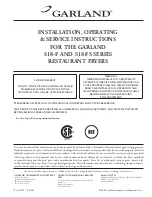
5
DRYER CARE
Cleaning the Dryer Location
Keep dryer area clear and free from items that would obstruct the
flow of combustion and ventilation air.
Cleaning the Lint Screen
Clean the lint screen before each load. A screen blocked by lint
can increase drying time.
IMPORTANT:
■
Do not run the dryer with the lint screen loose, damaged,
blocked, or missing. Doing so can cause overheating and
damage to both the dryer and fabrics.
■
If lint falls off the screen into the dryer during removal, check
the exhaust hood and remove the lint.
Every Load Cleaning
1. Pull the lint screen toward you.
2. Roll lint off the screen with your fingers. Do not rinse or wash
screen to remove lint. Wet lint is hard to remove.
3. Push the lint screen firmly back into place.
As Needed Cleaning
1. Roll lint off the screen with your fingers.
2. Wet both sides of lint screen with hot water.
3. Wet a nylon brush with hot water and liquid detergent. Scrub
lint screen with the brush to remove residue buildup.
4. Rinse screen with hot water.
5. Thoroughly dry lint screen with a clean towel. Replace screen
in dryer.
Cleaning the Dryer Interior
1. Apply a nonflammable household cleaner to the stained area
of the drum and rub with a soft cloth until stain is removed.
2. Wipe drum thoroughly with a damp cloth.
3. Tumble a load of clean cloths or towels to dry the drum.
NOTE: Garments which contain unstable dyes, such as denim
blue jeans or brightly colored cotton items, may discolor the dryer
interior. These stains are not harmful to your dryer and will not
stain future loads of clothes. Dry unstable dye items inside-out to
prevent dye transfer.
Removing Accumulated Lint
From Inside the Dryer Cabinet
Lint should be removed every 2 years, or more often, depending
on dryer usage. Cleaning should be done by a qualified person.
From Inside the Exhaust Vent
Lint should be removed every 2 years, or more often, depending
on dryer usage.
TROUBLESHOOTING
First try the solutions suggested here and possibly avoid the cost of a service call...
Dryer Operation
Dryer will not run
■
Check the following:
Is the power cord plugged in?
Has a fuse blown, or has a circuit breaker tripped? There
may be 2 fuses or circuit breakers for the dryer. Check to
make sure both fuses are intact and tight, or that both circuit
breakers have not tripped.
Was a regular fuse used? Use a time-delay fuse.
Is the dryer door firmly closed?
Was the Start button firmly pressed?
Is a cycle selected?
No heat
■
Has a fuse blown, or a circuit breaker tripped? Electric
dryers use 2 household fuses or breakers. The drum may be
turning, but you may not have heat.
■
Has an air dry cycle been selected? Select the right cycle
for the types of garments being dried.
■
For gas dryers, is the valve open on the supply line?
Unusual sounds
■
Has the dryer had a period of non-use? If the dryer hasn’t
been used for a while, there may be a thumping sound during
the first few minutes of operation.
■
Is it a gas dryer? The gas valve clicking is a normal operating
sound.
WARNING
Explosion Hazard
Keep flammable materials and vapors, such as
gasoline, away from dryer.
Place dryer at least 18 inches (46 cm) above the floor
for a garage installation.
Failure to do so can result in death, explosion, or fire.
Summary of Contents for Inglis
Page 7: ...7 Notes ...


























